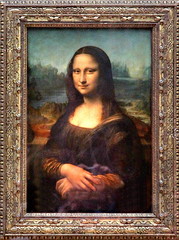Mona Lisa (also known as La Gioconda or La Joconde, or Portrait of Lisa Gherardini, wife of Francesco del Giocondo[1]) is a portrait by the Italian artist Leonardo da Vinci, says Wikipedia. It is a painting in oil on a poplar panel, completed circa 1503–1519. Property of the French State, it is on permanent display at the Musée du Louvre in Paris.
The painting is a half-length portrait and depicts a seated woman, Lisa del Giocondo, whose facial expression has been frequently described as enigmatic.[2] The ambiguity of the subject's expression, the monumentality of the composition, and the subtle modeling of forms and atmospheric illusionism were novel qualities that have contributed to the continuing fascination and study of the work.[1] The image is widely recognised, caricatured, and sought out by visitors to the Louvre, and it is considered the most famous painting in the world.
Leonardo took the painting from Italy to France in 1516 when King François I invited the painter to work at the Clos Lucé near the king's castle in Amboise. Most likely through the heirs of Leonardo's assistant Salai,[9] the king bought the painting for 4,000 écus and kept it at Château Fontainebleau, where it remained until given to Louis XIV. Louis XIV moved the painting to the Palace of Versailles. After the French Revolution, it was moved to the Louvre. Napoleon I had it moved to his bedroom in the Tuileries Palace; later it was returned to the Louvre.
Mona Lisa was not well known until the mid-19th century when artists of the emerging Symbolist movement began to appreciate it, and associated it with their ideas about feminine mystique.
In Italian, ma donna means my lady. This became madonna, and its contraction mona. Mona is thus a polite form of address, similar to Ma’am, Madam, or my lady in English.
Da Vinci used a pyramid design to place the woman simply and calmly in the space of the painting. Her folded hands form the front corner of the pyramid. Her breast, neck and face glow in the same light that models her hands. The light gives the variety of living surfaces an underlying geometry of spheres and circles.
The painting was among the first portraits to depict the sitter before an imaginary landscape and Da Vinci was one of the first painters to use aerial perspective.[29] The enigmatic woman is portrayed seated in what appears to be an open loggia with dark pillar bases on either side. Behind her a vast landscape recedes to icy mountains. Winding paths and a distant bridge give only the slightest indications of human presence. The sensuous curves of the woman's hair and clothing are echoed in the undulating imaginary valleys and rivers behind her.
Tuesday, December 13, 2011
Subscribe to:
Post Comments (Atom)





No comments:
Post a Comment